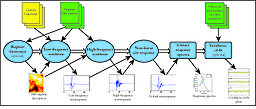Broadband Platform v11.2.3
The SCEC Broadband Platform is a software system which generates 0-10 Hz seismograms for historical and scenario earthquakes in California.
Contents
Overview
The goal of the SCEC Broadband Simulation Platform is to generate broadband (0-10 Hz) ground motions for earthquakes using deterministic low-frequency and stochastic high-frequency simulations. The SCEC Broadband Platform is a collaborative software development project involving SCEC researchers, graduate students, and the SCEC/CME software development group. SCEC scientific groups have contributed modules to the Broadband Platform including rupture generation, low-frequency deterministic seismogram synthesis, high-frequency stochastic seismogram synthesis, and non-linear site effects. These complex scientific codes have been integrated into a system that supports easy on-demand computation of broadband seismograms. The SCEC Broadband Platform is designed to be used by both scientific and engineering researchers with some experience interpreting ground motion simulations.
Users may calculate broadband seismograms for both historical earthquakes (validation events including Northridge, Loma Prieta, and Landers) and user-defined earthquakes. The platform produces a variety of data products, including broadband seismograms, rupture visualizations, and goodness-of-fit plots. Users can install the platform on their own machine, verify that it is installed correctly, and run their own simulations on demand without requiring knowledge of any of the code involved. Users may run a validation event, supply their own simple source description, or provide a rupture description in SRF format. Users may specify their own list of stations or use a provided list. Currently the platform supports stations and events in Southern California, the Bay Area, and the Mojave. Users may select among various codebases for rupture generation, low-frequency synthesis, high-frequency synthesis, and incorporation of site effects, with the option of running a goodness-of-fit comparison against observed or simulated seismograms. These codes have been validated against recorded ground motions from real events.
The Broadband Platform was implemented using software development best practices, including version control, user documentation, acceptance tests, and formal releases, with the aim of ease of installation and use.
Current Release
The current version of the Broadband Platform is v11.2.0 which was released on Friday, 18 Feb 2011.
Dependencies
Broadband has the following dependencies:
- Python 2.5+ with
- Intel compilers
and the following optional dependencies for additional functionality:
Documentation
User Guide Wiki (includes installation instructions): Broadband User Guide
Downloads
To install and use the Broadband platform, you need both the source code and the data files. There are detailed installation instructions in the Broadband User Guide. The main steps involved in installing the platform include:
- The software can be installed in an account on a Linux computer with at least 4GB of disk storage and C, Fortran, and Python software installed.
- From this Linux computer, start a web browser and point to this download page. Alternatively, you can download the files to a different machine and use FTP or SFTP to copy them over.
- Download the following four files (source, source md5sum, data, data md5sum) into a directory and run the md5sum program to confirm you have an undamaged version of the distribution files.
- Uncompress the distribution (tgz) files into data and source directory structures. The data files are nearly 3GB, but they are static and will not be modified and will not grow in size during use of the platform. The source directory is small, but this directory will increase as the platform is used, since the results produced by the platform will be stored here.
- Configure your environment to add broadband platform directories into your python path and define other useful environment variables.
- Build the executables by running the top level makefile.
- Confirm the code is built correctly by running UnitTests.
- Confirm the code runs correctly on your system by running AcceptanceTests.
- Use the platform for research purposes.
Source code
Broadband source (Python scripts, source code, unit and acceptance tests) (.tgz, 75 MB): bbp_dist_v11.2.0.tgz
md5sum (text, 62 bytes): bbp_dist_v11.2.0.tgz.md5
Data
Broadband data (Green's Functions, velocity model) (.tgz, 2.8 GB): bbp_data_v11.2.0.tgz
md5sum (text, 62 bytes): bbp_data_v11.2.0.tgz.md5
Supporting Materials
Broadband poster from AGU 2010 (PDF, 882 KB)
Broadband overview talk from SC10 (PPT, 3.7 MB)
Technical diagrams of Broadband module relationships (PPTX, 16 KB)
Development version
If you're interested in working with the latest development version of the platform, you can check it out from
svn co https://source.usc.edu/svn/broadband/trunk
Details about working with the development version are provided in the User Guide.
Help
For assistance with the Broadband Platform, you may
- Email software @ scec.org with specific questions
- Browse and submit new trouble tickets, or feature requests, at Broadband Trac site. SCEC user login is required to submit trouble tickets this way.
License
SCEC Broadband Platform software distributions are released under an Apache 2.0 open-source license as described here Broadband License.
Release History
11.2.0 - February 2011 - Initial release.
Collaborators
- ETH Zurich - Swiss Federal Institute of Technology Zurich
- San Diego State University Dept of Geological Sciences
- U.C. Santa Barbara Dept of Earth Sciences
- UCSB Institute for Crustal Studies
- URS Corporation
- SCEC
- SCEC/CME Project
See Also
References
- Graves, R. W. and A. Pitarka (2010). “Broadband Ground-Motion Simulation Using a Hybrid Approach.” Bull. Seis. Soc. Am., 100(5A), pp. 2095-2123, doi: 10.1785/0120100057. link
- Mai, P.M., W. Imperatori, and K.B. Olsen (2010). “Hybrid broadband ground motion simulations: combining long-period deterministic synthetics with high frequency multiple S-to-S back-scattering.” Bull. Seis. Soc. Am., 100(5A), pp. 2124-2142, doi: 10.1785/0120080194. link
- Schmedes, J., R. J. Archuleta, and D. Lavallée (2010). “Correlation of earthquake source parameters inferred from dynamic rupture simulations.” J. Geophys. Res., 115, B03304, doi:10.1029/2009JB006689. link
